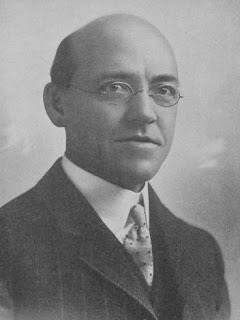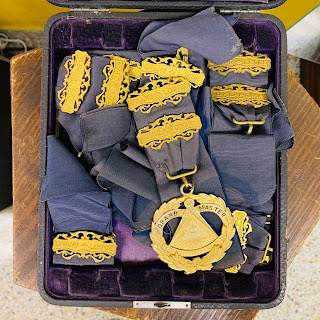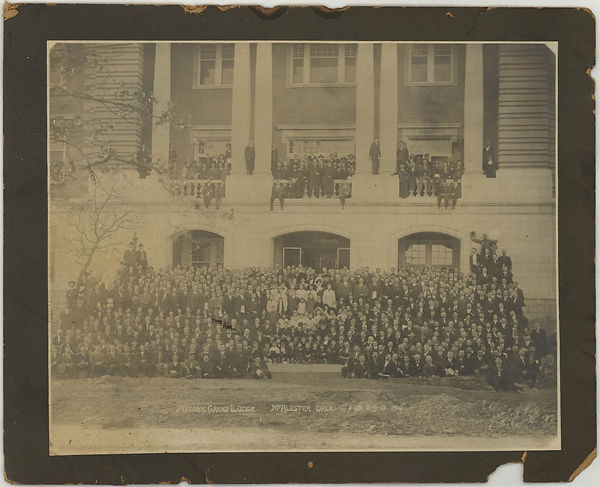“All that is essential for the triumph of evil is that good men do nothing.”
Oklahoma History
Oklahoma has been home to three grand lodges of Ancient Free & Accepted Masons. Interestingly, the state of Oklahoma itself was assembled from three different areas: the Indian Territory, No Man’s Land, and Oklahoma Territory. Beginning in the late 1820s, citizens of the Five Tribes (the Muscogee, Cherokee, Chickasaw, Choctaw, and Seminole) were forced west of the Mississippi River by the federal government. At that time, their new designated lands ran from the western border of Arkansas to the eastern border of Texas. Since the Missouri Compromise of 1820 prohibited slavery north of the thirty-sixth parallel, Texas surrendered a 168 x 34 mile-wide strip of land it had claimed since declaring independence, so that it could join the Union in 1845. The area was often noted as “Public Land'' on government maps, but became more commonly known as “No Man’s Land” as it remained unattached to any government until 1890. It was in that year that the Oklahoma Territory was formed, which is directly linked to the reconstruction treaties with the Five Tribes that were entered into in 1866. These punitive treaties imposed upon the Five Tribes for aligning with the Confederacy resulted in the western half of Five Tribes’ land being ceded to the federal government. Punitive treaties, such as these, were nothing new for the Muscogees for example, who suffered forced land reductions in 1790 and 1814. Though the Indian Territory likely could have, and should have, stood on its own as the state of Sequoyah with the wealth of the coal and oil fields in the region, it was from that territory, along with the Public Land, and Oklahoma Territory that the state of Oklahoma was organized in 1907. Both twin territories that became Oklahoma were fertile places for the spread of Freemasonry, and that growth led to grand lodges in each territory; grand lodges which ultimately created a new grand lodge following statehood.
With charters obtained from the Grand Lodge of Arkansas, Freemasonry quickly began to grow and prosper amongst the Five Tribes, leading to the formation of the Grand Lodge of the Indian Territory in 1874. Though outside of the bounds of the Chickasaw Nation, and thus outside of the Indian Territory, it was not a serious stretch for the Grand Lodge of the Indian Territory to grant a dispensation for a lodge to form on the Kiowa Reservation. It was, after all, still Indian country. On May 15, 1884, Grand Master Edmond H. Doyle granted a dispensation for the formation of a lodge at Anadarko.That lodge was chartered a few short months later on the 5th of November as the twenty-first lodge on the rolls of the Indian Territory and had sixteen Masons among its ranks by 1885.
The year 1889 would see an event occur that has come to define Oklahoma’s identity. People outside of Oklahoma may not know much about the state, but if one mentions the Oklahoma Sooners, they are likely familiar with that college football legacy. It is the Land Run of 1889 which brought forth the Boomers and Sooners of present-day Oklahoma fame. On that opening day of the land run in April of 1889, two cities of note came into existence before nightfall. The Santa Fe Railway crossed the Unassigned Lands, running north and south. Near where the railroad crossed the North Canadian River existed the Oklahoma Station. To the north, not far from where the railroad crossed the Cimarron River existed the Guthrie Station. Overnight, Oklahoma City and Guthrie came into existence, with streets laid out, town lots staked off, and steps taken towards forming municipal governments.[12] Within months, Freemasonry had taken hold at both cities. At Guthrie, Brethren were granted a dispensation to form a lodge on the 29th of August. At Oklahoma City, brethren received a dispensation to work as North Canadian Lodge on the 17th of September.[13] A grand lodge truly exists for administrative purposes to provide for regularity in Freemasonry. In this administrative capacity, it was the Grand Lodge of the Indian Territory that provided the necessary paper for the lodges at Guthrie and Oklahoma City to be established.
At the annual communication of the Grand Lodge of the Indian Territory in November of 1889, the question of issuing charters to both Guthrie and Oklahoma City was considered. In reviewing the records of Guthrie Lodge, the Committee on Charters & Dispensations found them to be “very irregular.” It was also noted that Guthrie had passed a newly initiated Entered Apprentice to the degree of Fellowcraft and raised him a Master Mason in a timespan of less than thirty days. The committee remarked on this, stating that it is a universal custom that every brother serves as an Entered Apprentice at least one lunar month before passing to the degree of Fellowcraft, and so on. The committee recommended that a charter not be issued to Guthrie at that time, and their dispensation be continued. Regarding North Canadian Lodge at Oklahoma City, the Committee on Charters & Dispensations received no evidence that the lodge had performed any Masonic degree work and recommended their dispensation be discontinued. Whilst the committee, chaired by Past Grand Master Edmond H. Doyle, reported poorly on these two lodges, it also reported poorly on other lodges under dispensation, but recommended charters for them. (Remember, it was Doyle who chartered the first lodge outside of the Indian Territory at Anadarko.) With that in mind, the delegates to the annual communication chose to show “charity and fraternity” to the brethren at Guthrie and Oklahoma City, setting aside certain laws and usages, and granted both charters. Thus Guthrie Lodge No. 35 and North Canadian Lodge No. 36 officially became constituent lodges of the Grand Lodge of the Indian Territory on November 6, 1889.
The Organic Act, which became law on May 2, 1890, provided for the formation of Oklahoma Territory and a territorial government. A governor and secretary were to be appointed by the President of the United States and a bicameral legislature was to be elected by the residents of the new territory. Guthrie was to be the provisional capital, courts were to be established, and seven counties delineated. Edmond also happened to be the next Oklahoma Territory town to secure a dispensation for a Masonic lodge on April 5, 1890. This was followed by Norman on the 28th of July of the same year. Both lodges were granted charters on November 4, 1890, becoming Edmond Lodge No. 37 and Norman Lodge No. 38. Stillwater was granted a dispensation for a lodge the following year on July 4, 1891, and that lodge was chartered less than thirty days later on the 18th of August as Frontier Lodge No. 48. The year 1892 saw the Grand Lodge of the Indian Territory charter an additional four lodges in Oklahoma Territory, which included: El Reno Lodge No. 50, Kingfisher Lodge No. 52, Hennessey (later Coronado) Lodge No. 56, and Chandler Lodge No. 58.
At the annual communication of the Grand Lodge of the Indian Territory in 1892 saw an important matter come before it. Selwyn Douglas of Oklahoma City introduced a letter before the assembled Craft asking consent for the lodges of Oklahoma Territory to form their own “separate and independent grand lodge.” The letter was referred to the Committee on Law and Usage who determined that the Grand Master of the Indian Territory would call a convention of the Oklahoma Territory lodges to consider the question of forming their own grand lodge and if those lodges chose to separate, the Grand Master would preside over the organization of the new grand lodge, its adoption of a constitution, and election of officers. The Grand Master of the Indian Territory would then formally claim that the new grand lodge was legally organized. These additional steps by the Grand Lodge of the Indian Territory were likely taken owing to the challenges she faced in obtaining recognition as a legitimate grand lodge from other jurisdictions.
August J. Spengel, the first Grand Master of Masons of Oklahoma.
(Courtesy of the Grand Lodge of the State of Oklahoma)
On November 10, 1892, at ten o’clock in the morning, in the Masonic Hall of Oklahoma City, Grand Master Leo Bennett assembled the lodges of the Oklahoma District for the purpose of forming a new grand lodge. Grand Master Bennett first ascertained who were the accredited representatives of the several lodges, finding the ten lodges of Oklahoma Territory represented. With thirty available votes, those men unanimously chose to move forward with separating themselves from the Indian Territory. The brethren then proceeded with electing their officers, selecting August J. Spengel of Guthrie as their first Grand Master. At eight o’clock in the evening, the officers of the Grand Lodge of Oklahoma were duly installed. At ten o’clock in the evening, the newly formed grand lodge was opened in ample form to conduct some necessary business, which included the renaming and numbering of the lodges.
Those lodges of the old Oklahoma District thus became:
Anadarko Lodge No. 1
Guthrie Lodge No. 2
Oklahoma Lodge No. 3 (formerly North Canadian)
Edmond Lodge No. 4
Norman Lodge No. 5
Frontier Lodge No. 6
El Reno Lodge No. 7
Kingfisher Lodge No. 8
Coronado Lodge No. 9 (formerly Hennessey)
Chandler Lodge No. 10
As a sign of good will toward the newly formed grand lodge, the Grand Lodge of the Indian Territory agreed to appropriate funds to purchase a complete set of grand lodge officer jewels for the Grand Lodge of Oklahoma.
The Grand Lodge of Oklahoma's original grand officer jewels.
(From the collections of the Oklahoma Grand Lodge Museum & Library)
The Grand Lodge of Oklahoma first met after its formation in November of 1892 on February 14, 1893, at El Reno. According to the annual proceedings of that body, the total number of Masons in the Oklahoma Territory was 437. Grand Master A.J. Spengel was carried forward as Grand Master, as was Deputy Grand Master Selwyn Douglas. One additional lodge was even chartered, Crescent Lodge No. 11 at Crescent City, which had just been granted a dispensation to organize on the 11th of January.
In 1896, the Supreme Court of the United States ruled that the south fork of the Red River was indeed the boundary established by the Adams-Onís Treaty. The Grand Lodge of Texas had established Masonic lodges in the disputed territory along the way. Mangum Lodge No. 685 had been chartered in 1889 and Altus Lodge No. 711 in 1891. The Grand Master of Texas wrote to the Grand Master of Oklahoma in May of 1896 to address the transfer of these two lodges. It was decided at the annual communication of the Grand Lodge of Texas at Houston in December, that the two lodges of Greer County should be transferred to the Grand Lodge of Oklahoma Territory (a reference to the principle of American grand lodges having jurisdiction over the states and territories in which they reside). The resolution offered to make the transfer was adopted by the Grand Lodge of Texas and on February 10, 1897, and the two lodges joined with Oklahoma Territory as Mangum Lodge No. 29 and Altus Lodge No. 30.
According to the pre-eminent Oklahoma Masonic historian Charles E. Creager, the popular proposal of the time was that the new State of Oklahoma would include only the Territory of Oklahoma.[37] The Twin Territories ultimately became the state of Oklahoma on November 16, 1907, and the new state found itself with two grand lodges within its bounds. According to the rules concerning Masonic regularity, this was not a situation that could prevail, and a remedy had already been set in motion.
The Oklahoma Enabling Act, signed by President Theodore Roosevelt on June 16, 1906, provided for the writing of a constitution for a state to be formed from the Twin Territories. The year 1906 also saw the process begin of merging the two grand lodges into one. A committee consisting of Masons from each of the territories was appointed that year and met in December at Oklahoma City. The plan for consolidation was laid out by the committee as follows:
Each grand jurisdiction was to be surrendered, in order that a new grand lodge could be organized by the two existing grand lodges; the new grand lodge was to be known as that of the State of Oklahoma; the Grand Master and Grand Senior Warden were to come from the Indian Territory, with the Deputy Grand Master, Grand Junior Warden, and Grand Treasurer coming from Oklahoma Territory; the balance of the grand officers were to be equally apportioned from each territory; the Grand Secretaries of each territory were to be retained, sharing the role geographically; the esoteric, or ritual, work of each grand jurisdiction was to be retained until the new grand lodge adopted work; and the charters of the original sixty lodges chartered by the Grand Lodge of the Indian Territory would revert to their previous numbers, with lodge numbers being determined after that based on their date of dispensation.
These details were to be considered by each grand lodge for approval by the Craft. The membership of each grand lodge at the time was roughly equal with 6,236 Masons in the Indian Territory and 6,777 in Oklahoma Territory. February of 1908 the Indian Territory delegation invited Oklahoma to send a similar delegation to their annual communication that coming August. The Oklahoma Territory delegation did indeed attend at McAlester and at that communication Joseph S. Murrow, known today as the Father of Masonry in Oklahoma, offered a resolution to provide for delegations from the Twin Territories to further outline the “details upon which a harmonious and fraternal union of the two Grand Lodges into one may be effected.” The resolution was adopted, and the two delegations conferred, reporting on the outcome of those discussions the following day. To bring about the merger of the two grand lodges, it was decided that the Grand Lodge of the Indian Territory would assemble on the second Tuesday of February 1909, the same time of the next annual communication of the Grand Lodge of Oklahoma. The two grand lodges were to each pass resolutions vesting their jurisdiction in the Grand Lodge of the State Oklahoma upon its organization and both grand bodies were then to meet in convention at Guthrie the following day to form the new grand lodge.
The Indian Territory delegates arrived at Guthrie and the convention was called to order at two o’clock in the afternoon by Past Grand Master David D. Hoag of Oklahoma Territory. He then introduced Past Grand Master Leo E. Bennett of the Indian Territory as the presiding officer of the convention. Bennett was no stranger to such a convention, having presided over the organization of the Grand Lodge of Oklahoma. With 1,400 Masons from the Twin Territories in attendance, a new Constitution, By-Laws, and Uniform Code were submitted for consideration and adopted. Grand Officers were elected, with Henry L. Muldrow, formerly of the Indian Territory, selected as Grand Master and George Ruddell, formerly of the Oklahoma Territory, as Deputy Grand Master The dawning of the twentieth century not only ushered into existence a new state, but it also brought forth the third Grand Lodge of Ancient Free & Accepted Masons to occupy the region that had become the state of Oklahoma, a region assembled from three principal geographic areas.
Grand Lodge of the State of Oklahoma at McAlester 1910


